Japanese Design Archive Survey
DESIGN ARCHIVE
University, Museum & Organization
Kyoto Institute of Technology Museum and Archives
Interview: August 27, 2021 13:30 - 15:00
Location: Online interview
Interviewee: Seishi Namiki (Director, Professor, Kyoto Institute of Technology)
Interviewers: Yasuko Seki, Akiko Wakui
Author: Akiko Wakui
Description
Description
The Kyoto Institute of Technology Museum and Archives was established in 1980 as an educational and research facility. Since the founding of the Kyoto High School of Arts and Crafts, one of the predecessors of the Kyoto Institute of Technology, in 1902, the museum has collected a wide variety of items, including domestic and foreign paintings, sculptures, drawings, metalwork, lacquerware, ceramics, textiles, and archaeological artifacts.
Of these, the museum places particular emphasis on its poster collection, one of the largest in Japan. The collection is based on posters that Chu Asai, a Western-style painter and Goichi Takeda, an architect who were professors at the time of the founding of the Kyoto School of Industrial Arts, collected for their design education while in Europe.
In 1995, the museum received a donation of architectural drawings by architect Togo Murano (including the original pieces), and, as a university museum, is making an active use of its archives in such a way as to directly benefit the education. For example, they open to the public the outcome of the archiving, research, and study, whenever the work is completed.
In addition, the museum has been carrying various projects involving an extensive area outside the university, such as the "Activities of the University Museum Association of Kyoto" and a survey in the field of graphics for the "Core Archive Center Creation Model Project" hosted by the Agency for Cultural Affairs.
Mr. Seishi Namiki, the director of the museum, has been a key person in this series of activities. In this interview, we asked him not only about the operation of the museum and the design archive, but also about the challenges facing the establishment of a design museum in Japan.
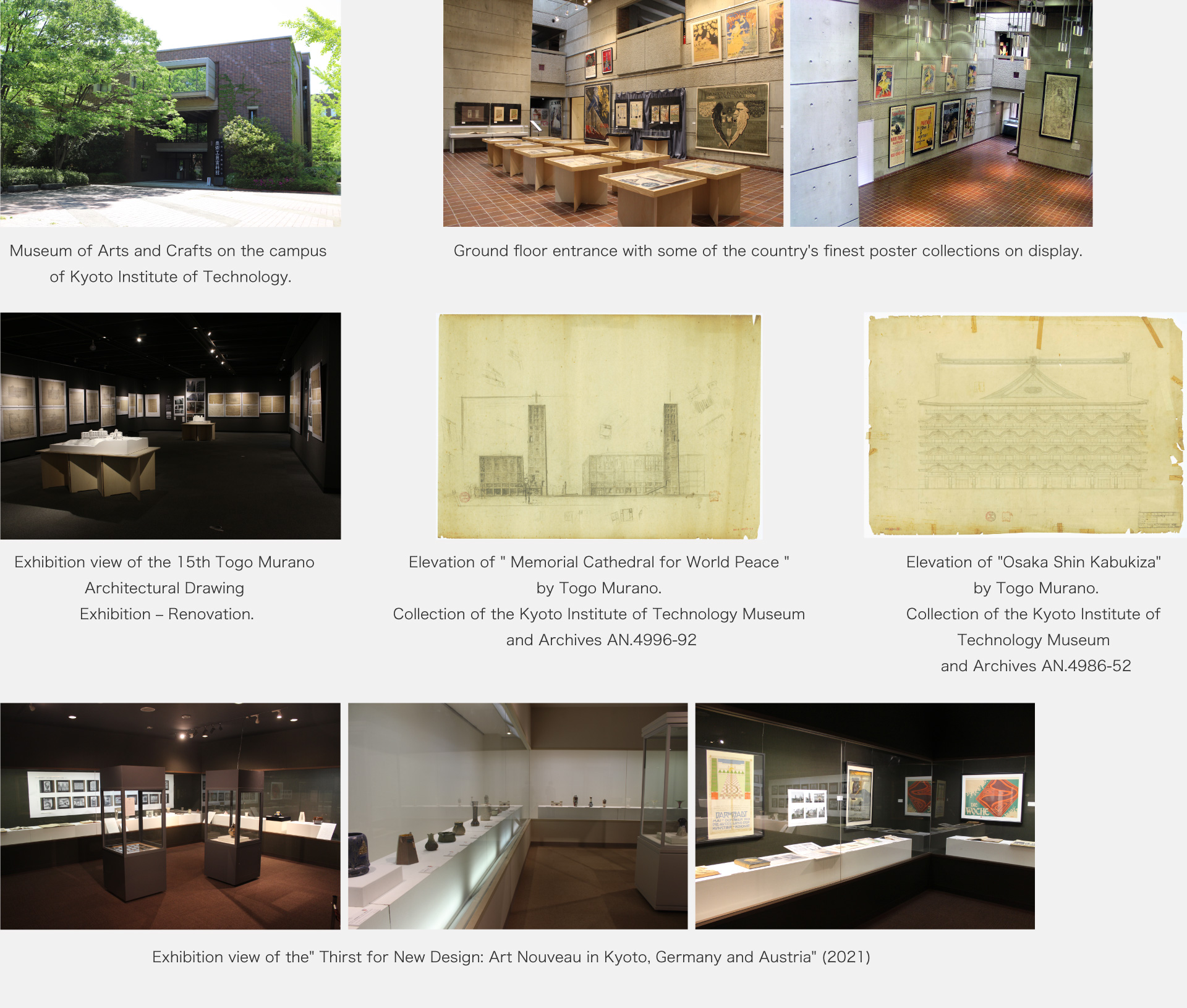
Interview
Interview
In order to create a name and format for a unified design archive, it is important to set up a project that can last for 10 years so that experience can be accumulated.
Background of the Establishment of the Museum
ー Nowadays, there is a growing interest in archives in various fields. This museum was established in 1980. Was there a particular reason why you recognized the importance of archives at a very early stage?
Namiki The Kyoto Institute of Technology was established in 1949 as a merger of two schools, one for crafts and the other for textiles, both closely linked with the traditional industries of Kyoto. At both schools real materials have been used for education since a relatively early stage. For example, posters were used to teach design, and models were used to teach how to make silkworms, and so on, since the end of the 19th century.
These materials were accumulated in the library. The library at that time had a multipurpose room where posters and artifacts were sometimes displayed. There was a movement to separate the arts and crafts into a different facility for a long time, not only because of space issues, but also because of the different storage methods for books and arts and crafts.
It was recorded that the university had requested a budget from the Ministry of Education much earlier than the actual year of Museum and Archives’ establishment, and had lobbied for the creation of an independent museum if possible.
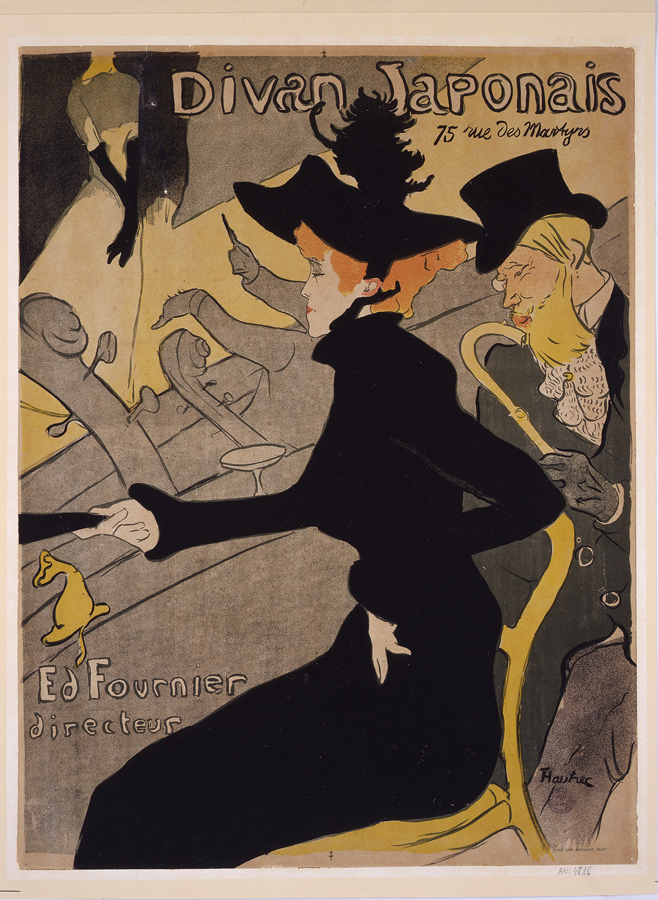
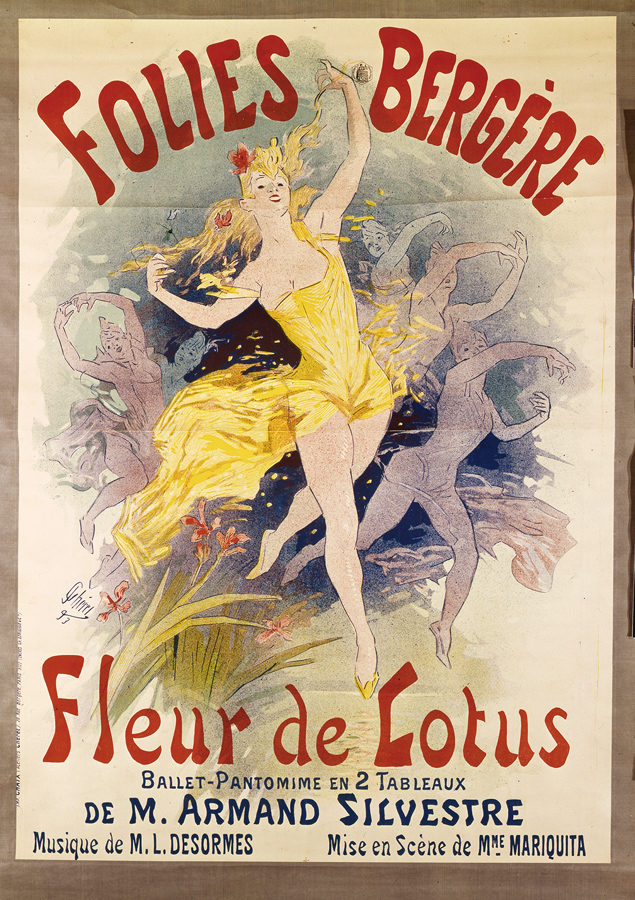
Left/Henri de Toulouse-Lautrec "Divan Japonais"(1892).
Collection of the Kyoto Institute of Technology Museum and Archives AN.4816
Right/Jules Chéret " Fleur de Lotus, Folies Bergère, " (1893)
Collection of the Kyoto Institute of Technology Museum and Archives AN.3363
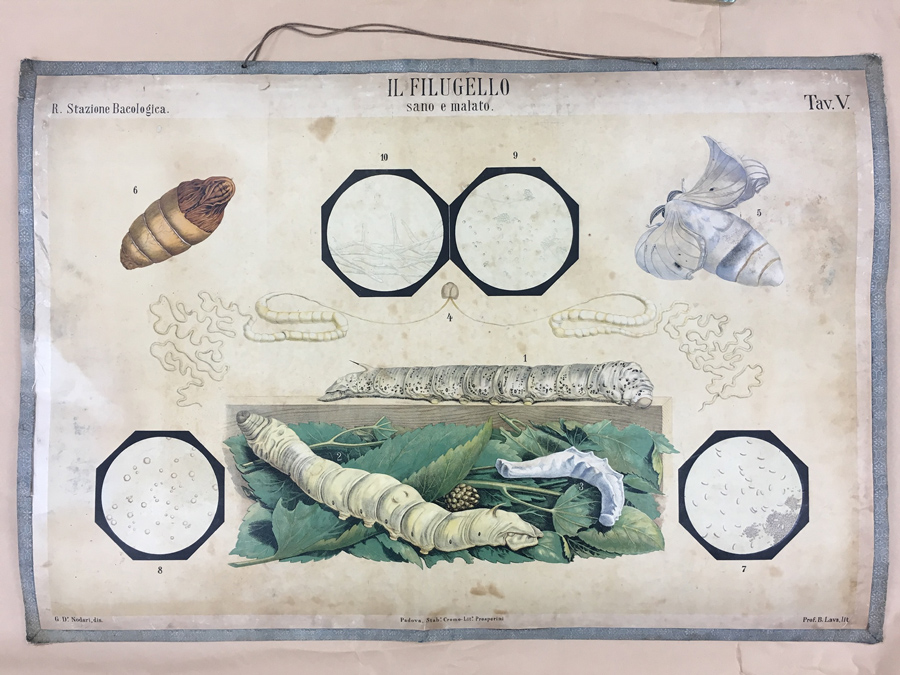
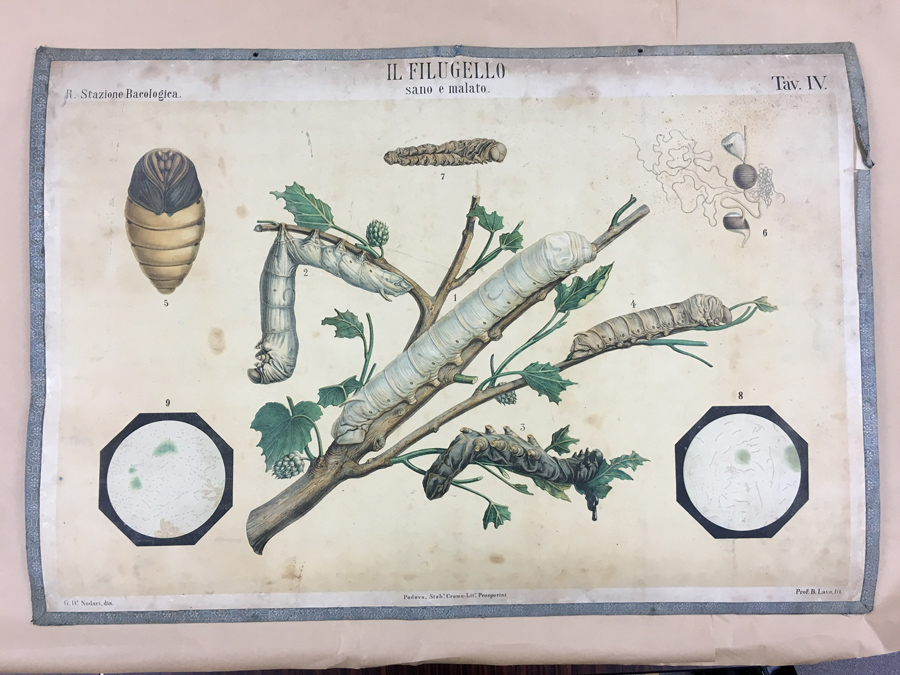
Italian sericulture teaching material “Atlante del filugello sano e malato (Atlas of healthy and diseased silkworm)” used at the Kyoto Sericulture Training School (1899-1913). Collection of the Kyoto Institute of Technology Library.
Management and human resources of the archives
ー How did you become the director of this museum?
Namiki I originally studied Japanese art history at Kyoto University. After graduation, I worked as a curator at the Tokugawa Art Museum in Nagoya, and then returned to the university to work as an assistant and teach at several universities, including Kyoto University of Art and Design. I am currently specialising in museums studies as well as Japanese art history. At Kyoto Institute of Technology, I taught courses in art history and curatorial qualifications.
I took over as the director of the museum in 2008, when the person who had been the director since the museum opened in 1981 retired. I myself retired in 2020, but this year, at the request of the university’s president, I became the director of the museum and thus continue to work as a specially appointed professor at the university.
ー Do you mean that you have always had a deep knowledge of archives?
Namiki My work at the museum mainly involves the conservation and management of the collection and the planning of exhibitions, so I am more involved as a researcher of art history or a curator of a museum than as a specialist in archives.
However, in the last ten years, I have become more and more involved in archives. As you know, the museum has one of the largest poster collections in Japan. These posters have been collected as teaching materials since 1902, when the predecessor of the Kyoto Institute of Technology opened. The museum has a collection of about 54,000 posters and other design materials. In the course of managing these materials, I have been involved in joint research on archiving of design-related materials under the auspices of a scientific research grant, and I have also been involved in a project to form an archive under the auspices of the Agency for Cultural Affairs.
ー How many people run the museum?
Namiki Apart from myself, there are two full-time professors, one specially appointed assistant professor who is researching the collection, and three administrative staff with curatorial qualifications. Since this is one of the university's administrative departments, the Information Management Section, so we have people who are doing their doctoral theses, who are reserve researchers, working as curators as technical officers for about five years. In fact, they sometimes plan exhibitions and sometimes help us with the exhibits.
ー These six people manage and operate about 10 exhibitions a year?
Namiki Most of the time, yes, but Mr. Waro Kishi himself participated in the planning of his exhibition, and the exhibition of educational materials is held together with curators from the Kyoto City Museum of School History and alumni of the university who are doing research together, so it's not necessarily just the staff inside.
Two pillars in collecting archives
ー The museum is famous not only for its poster collection, but also for its Japanese paintings and Togo Murano's architectural archive. You have a wide range of collections and materials; is there a collecting policy or criteria for accepting donations?
Namiki Being a university institution, we have a much smaller budget than most museums and galleries. As a rule we cannot buy new materials, so most of our new materials are donated to us. On rare occasions, if there is an item that fits with the collection policy of the museum and we can allocate a part of our operating costs to it, we will buy it.
The mainstay of our donations are materials relating to the arts and crafts of modern Kyoto and materials which can show the history of the University. Our predecessor school was established to provide scientific support for the traditional crafts of modern Kyoto, such as ceramics and dyeing and weaving, so we are happy to accept any offers of donations of materials relating to the history of the school.
Another pillar of our collection is materials related to our faculty members. As represented by Chu Asai and Goichi Takeda, these are people who have been teaching at the university since it opened, and we accept materials related to them that are significant in terms of art history or architectural history, to the extent that space permits.
For example, in the current exhibition "Waro KISHI_TIME WILL TELL", Mr. Waro Kishi was a teacher at our university from 1993 to 2010. As for the former director of the Kyoto Museum and art historian, Professor Tsugiyoshi Doi (Professor Emeritus of the University), the library and archives have taken in a large number of his handwritten notes and documents, organised them into an exhibition and lent them to other museums.
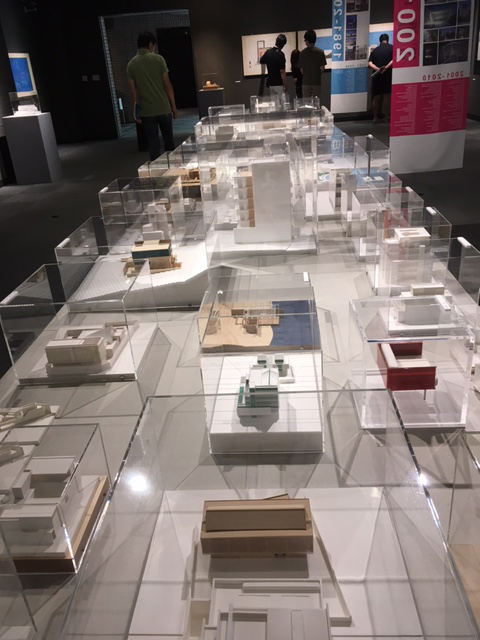
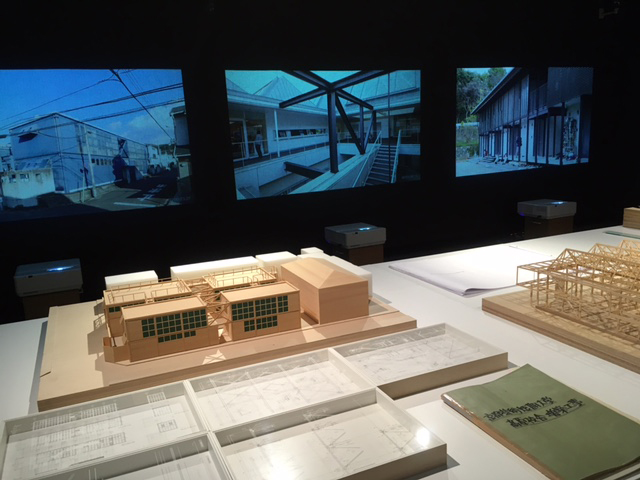
Exhibition view of the "Waro KISHI_TIME WILL TELL"(2021).
ー I had the opportunity to see Mr. Waro Kishi's exhibition along with the symposium. I was very impressed with the exhibition, which gave me a comprehensive view of Mr. Kishi's activities with models, drawings, and prints. This was my first visit to the museum, and I thought there would be many ways to use the museum, since it is an independent building with exhibition rooms on the first and second floors.
Namiki We hold about ten exhibitions a year, and the first floor and second floor are used for different exhibitions. The second floor is just a walled room, so the glass and ceramic works are displayed on the first floor where there are display cases.
ー Where is the storage room located?
Namiki It is on the third floor. We also have another old building that we use as a warehouse. Some of the items that are not affected by temperature and humidity are stored there.
ー Do you also hold exhibitions linked to the activities of the museum, such as presentations of the results of your archival research?
Namiki Yes, of course. For example, the exhibition I mentioned earlier on modern traditional crafts in Kyoto, which is one of the pillars of the archive, has been held continuously every year since 2010 with the support of the Agency for Cultural Affairs. While we mainly use the museum's collection, we sometimes collaborate with Kyoto City University of Arts and other institutions that have related materials in their collections.
There is another example. We are collaborating with the Kyoto City Museum of School History to hold an exhibition of educational materials for the " Education of Art / Art of Education " exhibition scheduled to open on September 27. Through these exhibitions, we are often contacted by people who say they have something like this in their house, and new materials are donated.
ー How do you use such archives for your students' classes and research?
Namiki One way is for students to come and see exhibitions related to their own specialties, and for teachers to show them to students as part of their classes. At that time, we sometimes explain the contents of the exhibition to the students, and at the request of their teachers, we sometimes collect materials related to the theme of their assignments and show them on the third floor.
We also provide museum training for students who want to become certified curators at the museum, so every year we teach 20 to 30 students how to handle materials and hold exhibitions planned by them.
Acceptance Criteria for Design Archives
ー You mentioned that the new collection is mainly donations, but the design archives contains a wide variety of things, from finished products to sketches, notes, and scraps of paper. When you accept these items, do you have any selection criteria or screening process?
Namiki I think it is very important for students who want to become designers or architects to see the creative process that leads to the final product. The design archives are not something that can be selected based on specific criteria, but I think it's most important to be able to show the flow of the result and the process, rather than just notes.
We don't have a set criteria for judging, but in the course of the donation discussions, we have been able to make some selections based on these factors.
ー What will be donated from the archives displayed at the exhibition by Mr. Waro Kishi?
Namiki We will discuss the specifics with Mr. Kishi, but now we are thinking that it will include the models, drawings and sketches used in the exhibition. The other thing is that Mr. Kishi's valuable books on architecture are going to be donated to the library, so I think that will also be part of the archive in a broader sense.
ー In the past, when Musashino Art University accepted the archive of the graphic designer Kohei Sugiura, it was impossible to organise the huge amount of works and materials, both in terms of budget and manpower. So, Mr. Sugiura himself visited the museum and worked with the people working on the archive project.
Do you think there is a possibility that you could organise Waro Kishi's archive with architecture students as part of their education?
Namiki We assume that the archiving will be carried out by Mr. Kishi’s students at the university as part of his seminar rather than as the museum’s initiative. In fact, they are helping us in many ways with this exhibition. I believe they are the most suited for this task and assume that Mr. Kishi will give us on-site help too.
In any case, the exhibition is not finished yet, so we will have to discuss about it in the future.
Consultation on donations to the museum
ー Does the museum's poster collection include works by contemporary graphic designers?
Namiki We receive donations in a variety of forms, so there are some contemporary pieces in our collection, but not many.
ー We often hear that people are having trouble finding places to host their archives. How often do you receive such requests?
Namiki If it's not just about design, it's relatively common. We don't necessarily accept everything, but we do consult with people. For example, we get at least one case a year from an alumnus of the university who works in traditional crafts in Kyoto, who wants to sort out his old things but can't just throw them away when he takes over or closes his business. We come across cases like this more than we do with requests from artists.
We may also be asked by a former college teacher for advice on what to do with the archives left by his father.
ー We hear that all museums are experiencing a tight squeeze on the availability of storage space.
Namiki We don't have one either.
ー When a creator dies, we often hear that the bereaved family cannot decide what to leave and what to dispose of. In such cases, do you sometimes go to the bereaved family's home to check the contents?
Namiki This is often the case. About four years ago we were asked by the family of one of our first students who had become a painter what we should do with the large number of sketches he had left behind. At that time, we received a donation of about 1200 sketches relating to the University, excluding those which the family wished to keep. These will be shown in a future exhibition.
ー On the other hand, I have heard of episodes where the creator of a work has said "I don't want to keep it because it's embarrassing" and thrown it away, but there was something of academic value in it, which the creator's student secretly picked up and kept. Are there cases like this where there is a gap between the intentions of the creator and the academic value of the work, and it is difficult to decide whether to keep it or not?
Namiki In the cases I have experienced, I have been entrusted with almost the entirety of the project, including cases where the creator has passed away, so there were no such complications.
The manga artist Sato Sanpei, who passed away recently, was an alumnus of the University and we had a major exhibition in 2014. At that time, I had the opportunity to see almost all of his original drawings while talking with him. I could understand the artist's feeling of not wanting to show his work because of his passion for it, but I have never had any problems with that.
ー I heard that Togo Murano's archive was organised by a research team while conducting research.
Namiki We don't have regular study groups, but we do have some graduates of our university who are curators at museums in Kyoto, so we sometimes have them come to do research, and we look at, select, and exchange opinions with them.
Background of participation in the Core Archive Center Creation Model Project
ー This museum was one of the three design organisations that took part in the Core Archive Center Creation Model Project of the Agency for Cultural Affairs. How did you become involved in that project?
Namiki Each of the three organizations has its own area of responsibility. We were in charge of graphic design, Musashino Art University was product design and Bunka Gakuen University was fashion design. To tell you the truth, I was personally involved in this project for three or four years before it started.
At that time, the staff of the museum, Kanazawa College of Art and The National Museum of Modern Art, Tokyo, were doing a joint research project for about four years, using a scientific research grant from the Ministry of Education, Culture, Sports, Science and Technology. I was a member of this project. The aim of this research was to see if we could create a uniform format for naming craft objects, which had been different in each museum collection, and we made a demonstration by collecting examples from various museums around Japan.
When the Agency for Cultural Affairs saw this, they said it was also difficult to name design products. When you’d like to identify a specific poster, you don't have a specific name for the work. We were asked if we could come up with a unified naming system for it, because we had a lot of data on design.
As you know, Ministry of Economy, Trade and Industry and the Agency for Cultural Affairs have been in a state of flux for many years regarding the creation of a design museum. So, the Agency for Cultural Affairs said that even if we do eventually build a design museum, it is impossible to collect all the objects in one place, so we need to create a network of museums. In order to create a network, we need to create a common language. I had a personal discussion with people from the Agency for Cultural Affairs about this.
So, I was approached by the Agency for Cultural Affairs, who asked me if I would be interested in starting a project, as they had a budget for research into design archives, and after discussions with Musashino Art University and Bunka Gakuen University, we decided to take on the project.
In other words, as part of the network building process towards the establishment of the Design Museum, there was a three-year project aimed at establishing a design archive, which was preceded by a project to unify the nomenclature of the collection of crafts and design products.
ー So the main aim of the project was to create an archive system with a design museum in mind. Have you continued the project in any way after its completion?
Namiki The results of the project are not in a state of development. We have been exchanging information with Musashino Art University and Bunka Gakuen University since then, but because of the different genres of materials in our collections, it has been difficult to unify them.
However, there has been some progress within the university. As I mentioned earlier, we had materials that had been used as teaching materials since the end of the 19th century, and the names of these materials were kept in the library ledger. We are now working on replacing those names with more generic ones and building a database.
Activities of the University Museum Association of Kyoto
ー The museum is a member of the "Activities of the University Museum Association of Kyoto". Can you tell us about the group?
Namiki "Activities of the University Museum Association of Kyoto" is a project that has been funded by the Agency for Cultural Affairs since 2011, and has been running for 11 years now. I was the chair of the committee until March this year.
Each university museum has its own unique collection and is involved in a variety of activities, but they are not well known. Our museum is located at the back of the university and it is difficult for the public to know about it. So, we decided that we should collaborate with other university museums in Kyoto to promote the museums and attract more visitors.
In the autumn of 2011, 15 university museums from 14 universities formed the "Activities of the University Museum Association of Kyoto". In February of the following year, a kick-off symposium was held at Kyoto Institute of Technology, and in October of the same year, the member museums of the Kyoto-University Museum Alliance each brought their collections to the Kyoto University Museum for a joint exhibition. This exhibition was well received by television and newspapers, and a similar group (University Museum Network of Kansai) was formed in Osaka.
Since then, we have held joint exhibitions not only in Kyoto, but also at the Kyushu Sangyo University Museum (2013), the Tohoku History Museum (2014), the Okinawa Prefectural University of Arts Library and Art Museum (2015), and in 2018 we collaborated with the Museum of National Taipei University of Education in Taiwan.
ー You were the initiator of this project! This organisation has been very active, organising regular stamp rallies to visit university museums in Kyoto, and I am envious because there are no such ongoing collaborative events in Tokyo.
Namiki There are a lot of universities in Kyoto and it's not a big city. So it's easy to do a stamp rally and visitors can enjoy different exhibitions at different universities.
ー Now that Activities of the University Museum Association of Kyoto has had an exhibition in Taiwan, do you plan to expand your activities to the rest of the world?
Namiki When ICOM (International Congress of Museums) was held in Kyoto in 2019, we found out that university museums around the world have limited budgets and publicity as single museums, while many have unique collections linked to the history of their respective universities, and that the global challenge is to do something about them. As one of the solutions to this problem, it is very meaningful to create a network and hold joint exhibitions, so I hope we can continue to do so.
ー This activity is a precursor to the idea that a network of collections is a realistic way to establish a design museum in Japan.
Namiki The number of design products is particularly huge, so trying to consolidate them all into one would be impossible and probably unfeasible. I think it's important to start from where you can, and I think the network is a very effective way of doing that.
ー As you say, design covers a very wide range of fields such as products, graphics, interior design and architecture. How do you think it should be archived in comparison to art and crafts?
Namiki I wish I could solve this problem, but it is very difficult. One thing I can say is how far we should go in pursuing the authorship of a single designer. If you start with an artist, such as Waro Kishi, who is having an exhibition now, Kohei Sugiura of Musashino Art University, or Ikko Tanaka, whose works are in DNP's collection, it's easier to expand. Even if there is a huge amount of work, if you think of it in the sense that the artist is involved in all of it, it becomes easier to see it as a whole.
On the other hand, there are of course things that are not authoritative. For example, there are products that are controlled by companies, or even more obscure ones. We have to find out how far we can pick up these things and how we can preserve them. In order to do this, we need to create a team of specialists, and we need to create a system that will allow us to do this on a long-term basis to a certain extent.
What is needed to realize a design museum?
ー In order to realize a design museum, I think it is important to organize the archives in a uniform format, what kind of system or organization do you think would be ideal for this?
Namiki I think that the Agency for Cultural Affairs should take the lead, but in order to build up experience, it would be difficult to do so unless the budget is set for a 10-year term rather than a single year. If the project is for three years, after the third year there is no guarantee at all. If we can set up a project that lasts at least 10 years, and if we can commit to not changing the person in charge or the core staff during that time, then I think the problems of unifying the name and creating a format will be solved to some extent.
ー That's right. It would be a shame if, after three years, the budget runs out and the project stops when it seems to have reached a certain level. I strongly believe that there should be a system that allows us to build on the achievements we have made so far.
Namiki The Activities of the University Museum Association of Kyoto also receives a grant from the Agency for Cultural Affairs every year and we have to start the paperwork every October.
It's a very complicated process, so we have to make sure that we have the human resources to continue every year. It is difficult to operate unless you can get a grant for a 10-year term. I think this is not only a problem for university partnerships, but also for setting up any kind of organisation.
Current situation of museums unable to afford to study archives
ー I think it is an important role for museums to develop not only exhibitions but also archives related to their collections, but the reality is that many museums have their hands full with special exhibitions. What do you think about this problem?
Namiki That's been a problem for a long time, but the operation of museums in Japan is based on special exhibitions. For example, at the Louvre, even though they don't have a special exhibition, people would visit. I think that's the way museums should be, but in Japan, if you don't do any big events and just hold permanent exhibitions, people think that museums are not doing anything. This is a tendency that has developed over the last 20-30 years. In other words, when you do a project that stands out, the media will pick it up and promote it, and the public thinks that's what the museum is doing. I think every museum has a conflict: if you hold a special exhibition, you can't do other work, and if you don't hold a special exhibition, you can't attract visitors.
ー After more than 20 years of preparation, the Nakanoshima Museum of Art, Osaka will finally open its doors. I'm very excited about the fact that archives will be a pillar of the museum there.
Namiki I know Mr. Sugaya, the director of the museum, very well. Fortunately or unfortunately the preparation time there was very long, so they could use that time to organize the archives. I think it was good in that sense.
The impact of the relocation of the Agency for Cultural Affairs and the Crafts Museum
ー The Agency for Cultural Affairs has decided to move to Kyoto, and last year the National Crafts Museum of the National Museum of Modern Art, Tokyo (now the National Crafts Museum) moved to Kanazawa. Do you think it is a catalyst for the promotion of local culture, or a positive factor for the art world as a whole, that cultural institutions that had been concentrated in Tokyo are now spreading to cities with their own unique culture?
Namiki The relocation of the Agency for Cultural Affairs is a transfer of people, and we don't see any real movement yet in terms of budget and so on, so I don't think it will have a big impact right now. It’s hard to tell because we don't have any concrete plans such as the creation of a central base for design research and collecting in the Kansai area. I think the decentration of cultural centres is a good thing for art lovers. As for the Crafts Museum, I think it is important not only to move to Kanazawa, but also to see how well it can integrate with the local crafts in Kanazawa.
ー Yes, that is true. I hope that the relocation of the Agency for Cultural Affairs to Kyoto, which is the centre of Japan's ancient culture, will not only result in the transfer of people but also in new activities for the Agency. Thank you very much for your time today.
Enquiry:
Kyoto Institute of Technology Museum and Archives
Hashigami-cho Matsugasaki Sakyo-ku Kyoto-shi Kyoto 6068585 JAPAN
Open: 10:00〜17:00
Closed: Every Sunday, National holiday

